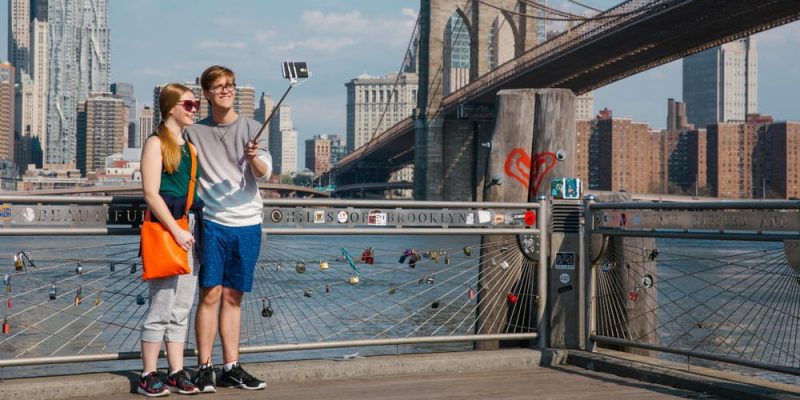We explain what a selfiewhat types exist and what it is for selfie stick. Also, the history of the selfie and which are the most famous.

What is a selfie?
The selfie or selfie (from English selfie either selfie) It is a self-portrait photograph, that is, taken by the same person who appears in it. The term generally refers to photographs of this type taken with digital cameras or cameras integrated into a cell phone, and is a practice massively adopted in times of social networks, although its invention, strictly speaking, dates back to the beginnings of photography.
the word selfie It is an anglicism, that is, a loan from English that replaces “self-portrait” or, rather, “selfie.” It emerged and became widespread at the beginning of the 21st century, thanks to the incorporation of cameras in cell phones. The first recorded use of this word on the internet dates back to 2002, in a forum called ABC Online; And in 2013, the prestigious Oxford English dictionaries chose the term as the “English word of the year.”
Like all Anglicisms, selfie It is written in italics in the Spanish language, and can be used in both singular and plural (selfies), or use Spanishization selfie and selfies.
See also: Hashtag (#)
History of the selfie
The photographic self-portrait is almost as old as photography itself. In fact, at the time of the daguerreotype in the 19th century, the American Robert Cornelius (1809-1893) took a self-portrait in 1839 On the back of which he wrote: “The first light photograph ever taken. 1839.”
However, recently With the invention of the Kodak Brownie portable box camera in 1900, photographic self-portraits became popular generally using a mirror or some reflective surface, as in the case of the portrait of the (then) adolescent Anastasia Nikolayevna Romanova (1901-1918), Grand Duchess of Russia executed during the Bolshevik Revolution.
The first group self-portrait came shortly after, in 1920, and was taken in New York by the American photographer Joseph Byron (1847-1923), along with four of his colleagues. In the latter case, the deformation of the lens is noticeable on the image, taken holding the camera between two, given that it was quite heavy.
With or without a mirror, the photographic self-portrait continued to become popular throughout the 20th century, long before the internet, social media and the word “selfie.” In this sense, the work of the Venezuelan photographer Vasco Szinetar (1948-) also stands out, renowned portraitist and author of a large collection of self-portraits with artists and writers in front of the mirror, developed over several decades.
Finally, The arrival of the Internet and cameras on cell phones allowed the massification of selfie and its separation from the professional photographic field. With the arrival of social networks in the 2000s, everyone wanted to take selfies and share them with their contacts, emulating the gesture of film and television celebrities such as Paris Hilton and Britney Spears, whose selfie from 2006 was often and wrongly heralded as the first of its kind in history.
First selfies
Some of the first selfies in history are the following:
- selfie by Robert Cornelius (1839)


- selfie by Anastasia Romanov (1914)


- The first selfie group (1920)


- selfie by Joseph Byron (circa 1920)


- selfie by Frank Sinatra (1938)


- selfie by George Harrison before the Taj Mahal (1966)


- selfie by Vasco Szinetar with Jorge Luis Borges (around 1980)


- selfie by Paris Hilton and Britney Spears (2006)


Types of selfies
In some places a classification of the selfie based on its style and content. These types of selfies are:
- selfie. It is the ordinary self-portrait, whether in front of the mirror or turning the camera towards us. It has become much easier to take since cell phones have a front camera (or rear camera). selfie).
- Usie. Its name comes from the English pronoun us (“we”), and it is the selfie group.
- OOTD. It is a type of selfie, generally full body, in which emphasis is placed on the clothing one is wearing. Its acronym corresponds to Outfit Of The Day (“dress of the day”). It is typical of social networks and influencers that advertise different clothing brands.
- helfie. Its name comes from the combination of selfie with the english word hair (“hair”), so it is a selfie in which the hairstyle or hair is given prominence.
- morningselfie. Its name in English translates “selfie “morning” and consists of taking a self-portrait while still in bed and without getting ready.
He selfie stick

It is known as selfie stick to a type of accessory for cell phones that It consists of an extendable stick, at the end of which the cell phone is connected and that allows the maximum distance of the extended arm to be exceeded to take a selfie. This makes it easier to frame the photo and allows you to take a larger portion of the surrounding landscape, making it a very popular tool among social media and self-portrait addicts.
Continue with: Meme (internet)
References
- “Selfie” on Wikipedia.
- “This is how the selfie was born and evolved (and Paris Hilton and Britney Spears did not invent it)” on BBC News Mundo.
- “World Selfie Day: Who took the first-ever selfie?” in The India Times.
- “Selfie (photograph)” in The Encyclopaedia Britannica.





